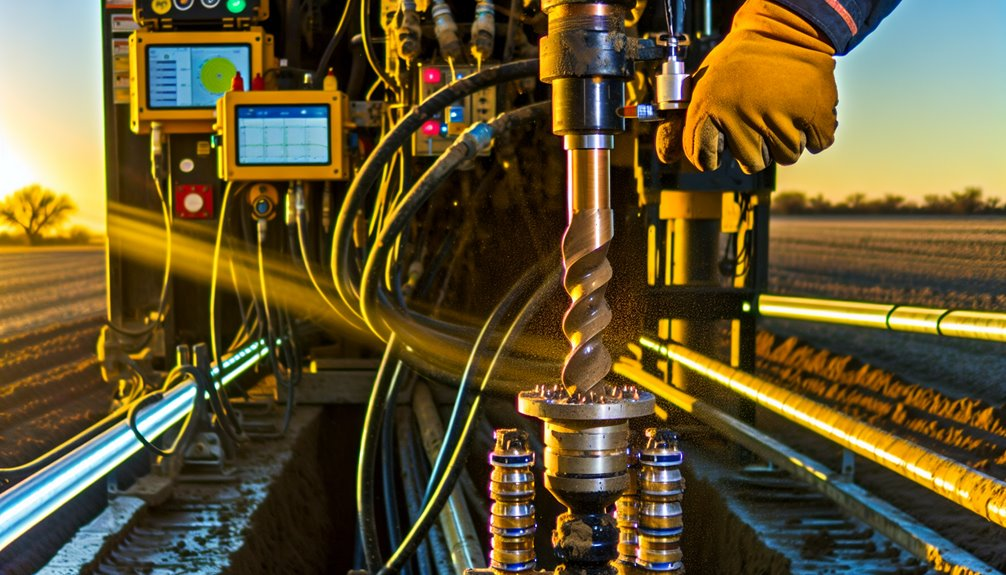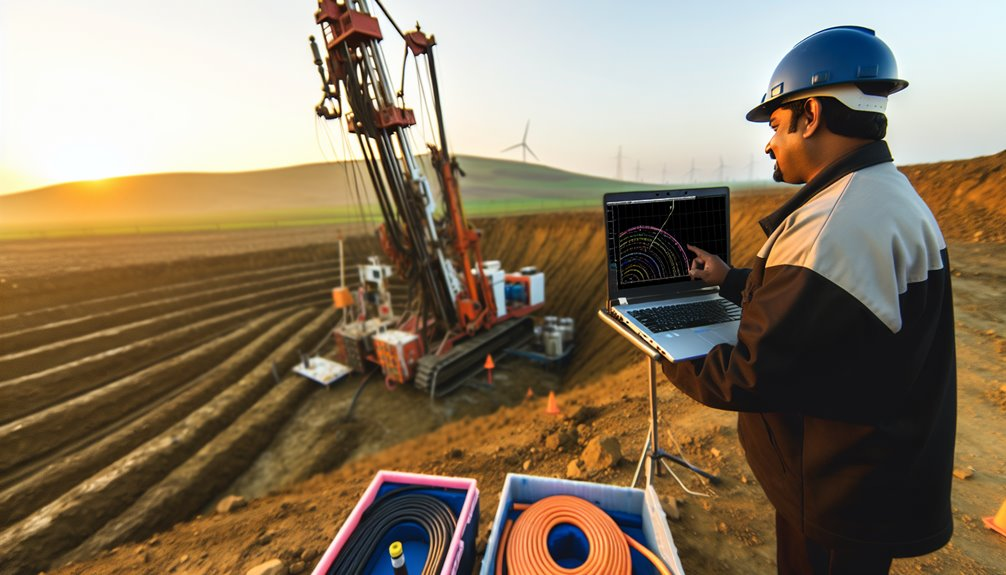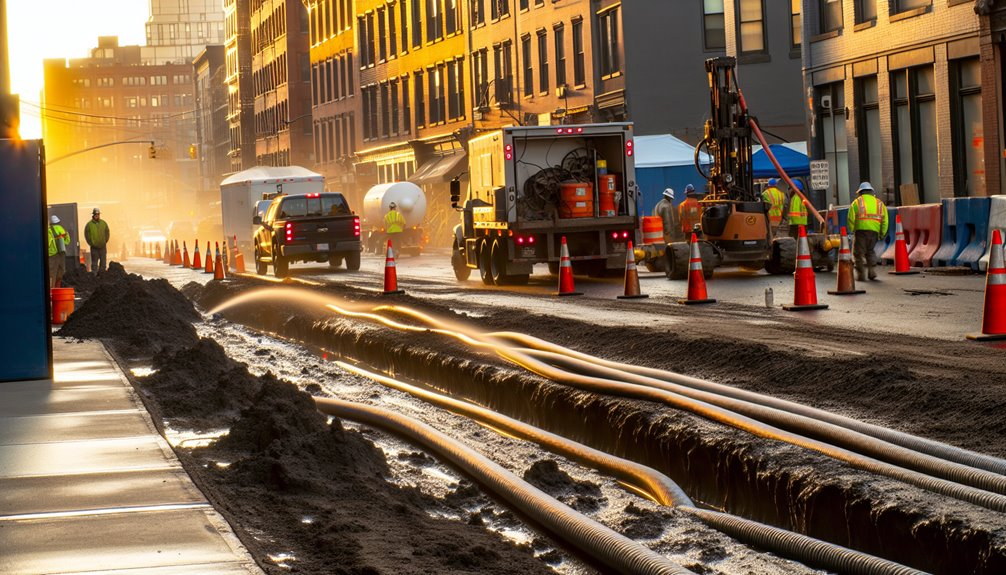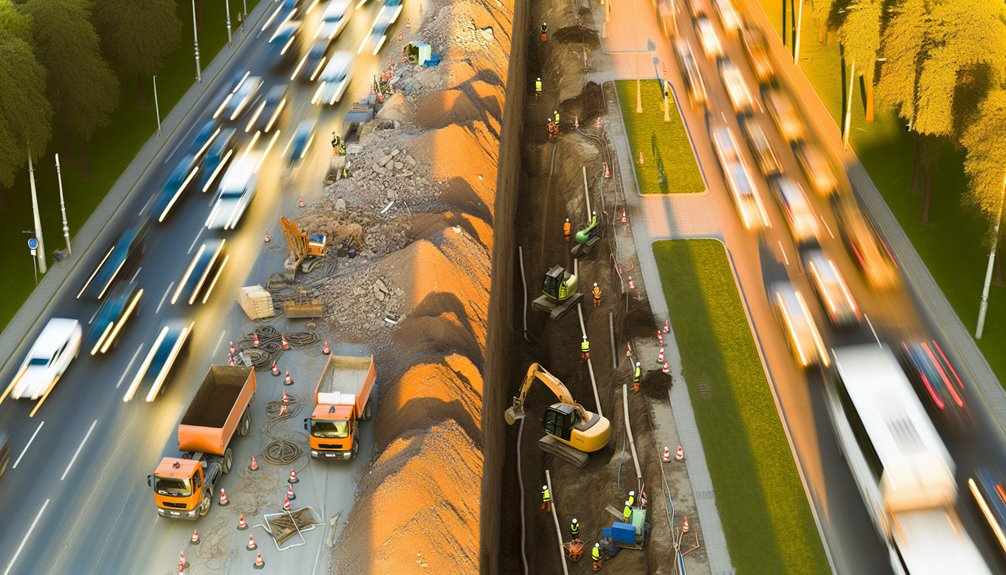You care about HDD precision because advanced rigs close the loop between plan and bore. Real-time steering keeps inclination, azimuth, and dogleg within spec. High-resolution MWD/LWD and telemetry remove guesswork. Closed-loop torque/thrust control protects tools and pipe. Intelligent mud systems stabilize the hole and cut cleanup. Automation cuts human error and NPT. Predictive maintenance boosts uptime. Environmental controls reduce surface risk. The payoff shows up in auditable outcomes and lower installed-foot cost—now consider what happens without it.
Real-Time Steering for Tighter Bore Paths

Although formation variability will never disappear, real-time steering lets you hold tighter bore paths by closing the loop between downhole telemetry and surface control. You adjust toolface within seconds, not stands, keeping walk and sag inside ±0.5% depth. With real time calibration routines, you correct magnetic bias and accelerometer drift on the fly, cutting positional error by 30–50%.
High-resolution bore path visualization aligns inclination, azimuth, and curvature rate so you honor design radii and avoid overstressing product pipe.
You’ll tune weight-on-bit, rotary speed, and flow to maintain steerability while preserving ROP. Consistent slide/rotate ratios stabilize dogleg severity under 2.5°/30 m, reducing reamer torque spikes and fluid losses. Teams that standardize these practices see fewer frac-outs, cleaner intersect windows, and predictable as-built reports.
Telemetry and Data Logging That Eliminate Guesswork
Streaming the right measurements at the right cadence turns HDD from feel-based to evidence-based. You instrument the drill string with accelerometers, magnetometers, and pressure transducers, then blend signals through sensor fusion to suppress noise and bias. High-frequency telemetry feeds depth, inclination, azimuth, annular pressure, and fluid density to your rig display and cloud storage. You audit every correction, compare plan vs. actual, and quantify variance so crews align decisions across shifts.
With synchronized logs, you trace root causes, validate formations, and preempt frac-outs, losses, and re-drills. Data doesn’t replace judgment—it sharpens it and makes it shareable.
- Confidence in every adjustment
- Pride in a clean as-built
- Relief when trends confirm plan
- Unity across field and office
- Momentum from proven wins
Torque and Thrust Management to Protect Tooling

While torque turns cutters and thrust advances the bit, unmanaged loads shorten tool life and spike failure risk. You prevent that with closed-loop torque control and responsive thrust regulation tied to real-time downhole data.
Set thresholds based on formation compressive strength, bit diameter, and cutter count; then hold torque within ±5% and weight-on-bit within a narrow window to avoid micro-chipping and spline fretting.
Monitor stick-slip, stall frequency, and overpull events; if torque oscillation exceeds set bands, trim RPM and increase flow to stabilize cuttings evacuation.
Calibrate breakout torque to joint spec to curb shoulder galling. Log torque-per-foot drilled to benchmark dull grades.
This discipline delivers tooling protection, smoother energy transfer, fewer tripping events, and measurable cost-per-foot reductions across your crew.
Intelligent Mud Systems for Stability and Cleanup
Dial in intelligent mud systems to stabilize the hole, control pressures, and clear cuttings with minimal nonproductive time. You monitor mud rheology in real time—PV, YP, gels—to balance suspension and ECD, keeping annular velocities above the slip threshold while avoiding frac-out. Smart mixers dose polymers and LCM automatically; density and viscosity stay within tight bands, so torque spikes drop and returns stay clean.
With fluid recycling, you cut water use by up to 60% and reclaim solids to <3% by volume, protecting pumps and MWD. Downhole pressure sensors feed a closed-loop algorithm that tunes flow rate and RPM to maintain stability through shifts.
- Validate the plan
- Trust the readings
- Own the trenchless craft
- Protect the crew
- Deliver a clean bore every time
Automated Rod Handling for Speed and Safety

Accelerate make-up and break-out with automated rod handling that removes hands from the danger zone and compresses cycle time.
You’ll add 10–20% more joints per hour by eliminating manual stab time, misalignment, and inconsistent torque.
Integrated sensors confirm thread engagement, rotation speed, and target torque, documenting every connection.
With crew safety automation, you cut pinch, crush, and struck-by exposures while keeping operators behind guarding and interlocks.
Automated rod handling standardizes makeup torque to spec, reducing galling and premature thread failure.
You’ll see straighter strings, fewer connection leaks, and cleaner pump curves.
Cycle counters, error codes, and auto-grease routines drive predictive maintenance, so uptime stays above 95%.
Training is faster, too: one console governs loader, carousel, and wrench, letting your crew work as one—faster, safer, and repeatable.
Precision Locating to Avoid Strikes and Crossings
Because subsurface congestion keeps rising, precision locating becomes your primary control to prevent strikes and unauthorized crossings. You validate targets with calibrated transmitters, dual-frequency receivers, and real-time depth/azimuth readouts, not just line of sight. You reconcile utility maps with potholing data, EMI scans, and tolerance bands (±0.1–0.2 ft depth, ±0.5–1.0 ft lateral) before each shot.
During pilot, you log heading variance and roll drift; any deviation beyond limits triggers corrective steering or stand-down. You geo-stamp every locate to create audit-ready as-built paths and prove separation from live plant.
- You protect crews and neighborhoods.
- You earn trust with repeatable, audited data.
- You prevent downtime, claims, and permits at risk.
- You prove craft pride in tight corridors.
- You bring everyone home.
Adaptive Tooling for Variable Ground Conditions

With targets locked and verified, you need cutters and assemblies that match what the ground actually throws at you. You face sand lenses, clay seams, and cobble bands in a single 300-foot shot. Variable cutters let you swap tooth profiles and carbide densities to keep specific energy under 15–25 kWh/m³ across transitions. Pair them with adaptive stabilizers that modulate gauge contact to hold a 0.2–0.4° dogleg while limiting lateral vibration below 0.6 g.
You’ll read torque and ROP in real time: when torque spikes 12% and ROP falls, you upflow, shift to more aggressive inserts, and re-balance the BHA. In silts, reduce cutter aggressiveness, tighten stabilizer spacing, and maintain laminar returns. This is how crews stay on line, protect pipe, and belong on tight corridors.
Downtime Reduction Through Predictive Maintenance
Start by treating downtime as a measurable failure mode you can predict and prevent.
Instrument your rigs with predictive sensors on pumps, mud motors, and rotary heads, then baseline vibration, temperature, pressure, and current draws. Use thresholds and trend analyses to trigger Maintenance scheduling before components drift out of spec. Tie sensor alerts to parts inventory and crew calendars so you swap consumables at optimal intervals, not after failures. Validate results: track mean time between failures, unplanned stoppages per 1,000 drilling hours, and cost per meter.
- You keep the crew productive and proud.
- You finish crossings on time—together.
- You protect margins when others scramble.
- You trust the data, and each other.
- You lead the standard the field respects.
Environmental Controls That Minimize Surface Impact

Although HDD already reduces disturbance versus open-cut, you can further shrink the surface footprint by engineering environmental controls into the plan, rig-up, and execution.
You instrument the site with real-time surface monitoring—tiltmeters, piezometers, and UAV orthomosaics—to detect settlement, frac-outs, and fluid seepage within tolerance bands.
You size containment to predicted annular pressure using rheology data and downhole ECD models, then calibrate pumps to maintain target PV/YP and gel strengths.
You deploy closed-loop recycling, double-lined pits, and vacuum recovery to prevent offsite transport.
For erosion prevention, you stage wattles, compost socks, and rapid-hydration tackifiers based on slope, rainfall intensity, and soil erodibility (RUSLE K-factor).
You enforce track-out controls, wheel washes, and stabilized entrances, then verify remediation with post-bore lidar.
Total Cost of Ownership Benefits Over Project Lifecycles
Even before mobilization, advanced HDD tooling shifts your cost curve by lowering failure probability and shortening cycle times across design, drilling, and restoration.
You capture lifecycle savings via fewer unplanned pulls, tighter bore path control, and reduced ream passes.
Precision sensors cut nonproductive time; higher torque-per-weight drives reduce fuel per foot.
Standardized tool interfaces speed swaps, shrinking standby charges.
Over multiple projects, asset depreciation spreads across more productive hours, improving cost per installed foot.
Parts traceability and predictive maintenance extend service intervals, limiting crew overtime and liquidated damages risk.
- Confidence when the bore stays on line
- Relief when rigs leave on schedule
- Pride in data that proves you efficient
- Trust built by repeatable outcomes
- Belonging to a crew that delivers under pressure
Conclusion
At Boring Bros, I’ve seen how the right equipment makes all the difference — when our HDD plan lines up with the bore we drill, everyone wins. With advanced rigs we steer in real time, capture high‑resolution telemetry, control torque and thrust to protect tools and pipe, and use intelligent mud systems to stabilize the hole and speed cleanup. Automated handling keeps cycles fast and safe, adaptive bits hold the line in mixed ground, predictive maintenance cuts downtime, and environmental controls help prevent frac‑outs. The result is fewer re‑drills, auditable precision, less NPT, and a lower installed‑foot cost across projects. If you’d like to learn more, I’d love to talk — visit boringbro.com or give us a call at (954) 639-6167.




